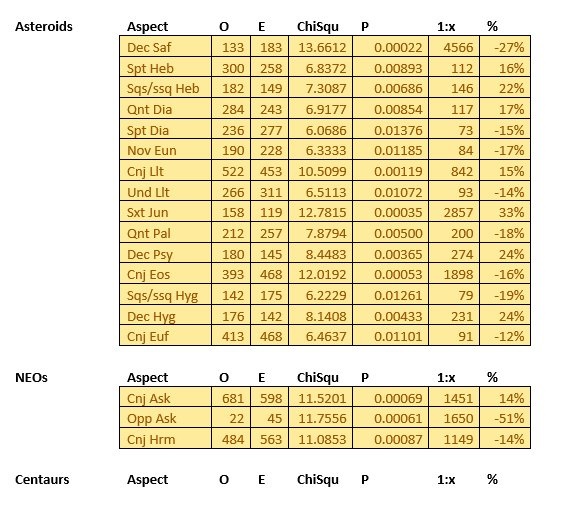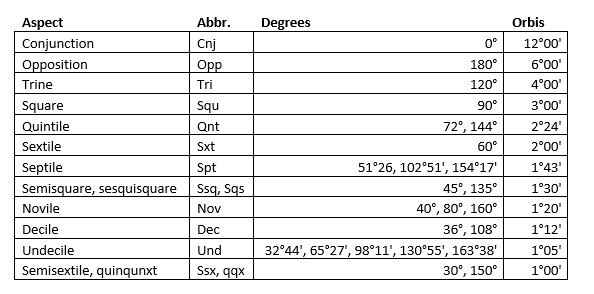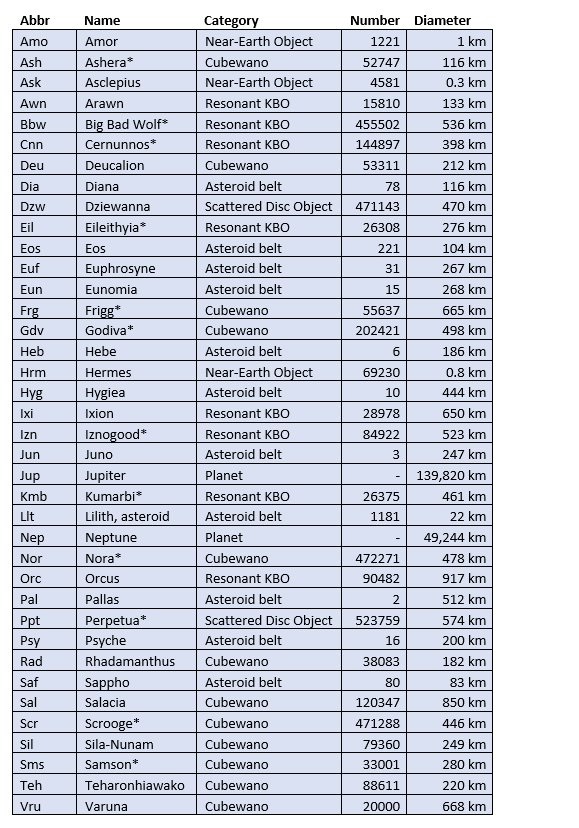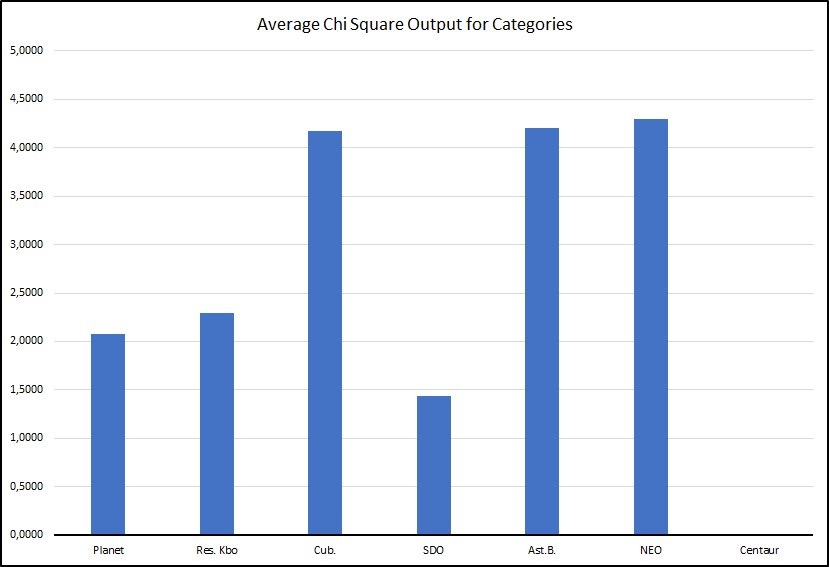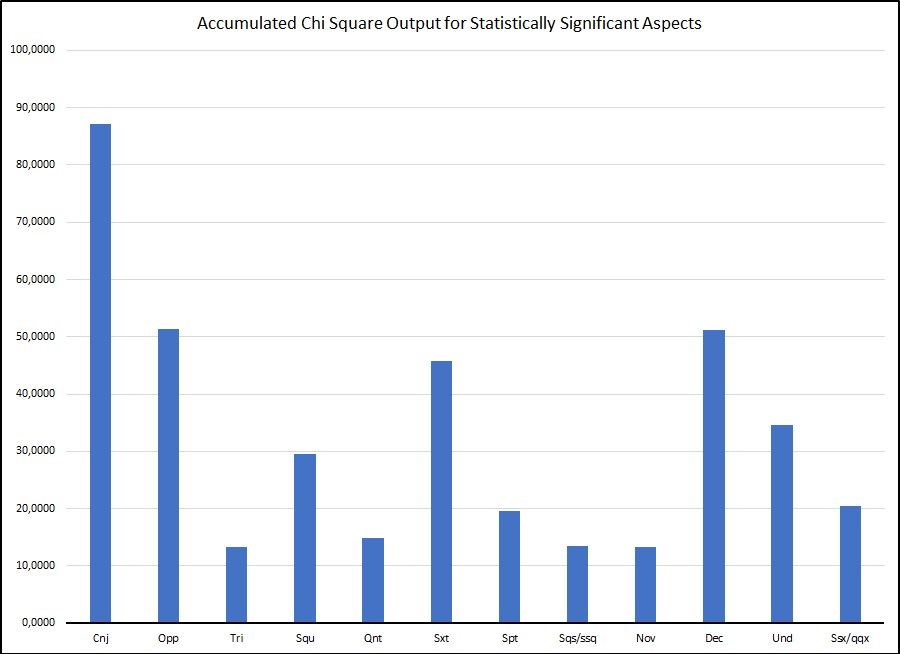Solar aspects
As indicated in this section the normal procedure when working with statistics is to set the P-value (P for probability) to 0.05. In other words, if an incident happens with the likelihood of 1 out 20 to happen by chance, then that observation is deemed statistically significant. However, we cannot use 0.05 as the P-value in the following section about the Sun's aspects to various celestial bodies, and in the following I shall explain why.
First some numbers: The present investigation into the Sun's aspects include 130 celestial bodies, and the accumulated number of investigated aspects is 1,543. If I use a P-value of 0.05, then I would expect 77 of the found "statistically significant" aspects to have happened by accident - namely 5% of 1,543.
I did find 128 aspects with a P-value equal to or below 0.05. This means that 51 of the aspects can be expected to be genuinely statistically significant. At least that is one way of solving the problem: To elevate the 51 found aspects with the lowest P-value to be genuinely statistically significant.
There is another solution to the problem: If I divide the 5,040 data into 2 sets with each set consisting of 2,520 data, then I can identify the aspects with a P-value equal to or below 0.05 and existing in both data sets - these are the aspects, which have been replicated. Finally I can use the P-values in these 6 aspects to estimate a general P-value, which I can use for the non-replicated aspects as well.
I found 6 such replicated aspects. I used these 6 replicated aspects to identify a P-value of 0.015. When I use this new P-value on the entire data set of 5,040 data, I end up with 46 genuinely statistically significant aspects among which 4 are replicated - i.e. existing in both the 2 sets of each 2,520 data. The 46 genuinely statistically significant aspects with a P-value equal to or below 0.015 are listed below in Table 1 and Table 2.
In the following I shall first explain all the abbreviations in Table 1 and Table 2. Finally I shall try to make some conclusions regarding the found observations.
When I work with aspects, I use the orbis recommended by John Addey, and which are displayed in Table 3.
The celestial bodies, I have researched, can be categorized in the following categories:
- Planet: The "regular" planets are Mercury, Venus, Mars, Jupiter, Saturn, Uranus and Neptune. However, I have included the lunar node and the mean lunar apogee (also known as Lilith the Black Moon); both are invisible points derived from the lunar orbit.
- Ressonant KBO's: You will have to look up the definition of "Resonant KBO" at Wikipedia, but I can inform you that "KBO" is an abbreviation for "Kuiper Belt Object". The Kuipber Belt is outside Neptune's orbit. I have included 10 resonant KBOs in this project. among them is Pluto.
- Cubewano - also known as "Classical KBO's": Apparently they are the KBO's, which are not "resonant", and in my project I have included 17, among them the biggest and probably most wellknown is Makemake. You can read more at Wikipedia about Cubewanos here.
- Scattered Disc Objects - also known as SDO's. As I understand it the SDO's are outside the Kuipber Belt and not influenced by the gravity of Neptune - but I am not sure about the latter. So far I have only included 7 SDOs, among them the biggest and most wellknown is Eris. You can read more about the scattered disc here.
- Asteroid Belt: There is an almost infinite number of celestial bodies in the asteroid belt - I have include 18 of them in this project, among them the biggest and probably most wellknown is Ceres.
- Near Earth Objects - als known as NEOs. NEOs are asteroids with orbits between the Asteroid Belt and the Sun. In astrology one of the most wellknown NEOs is probably Eros, which I have seen mentioned in several astrology books. I have included 7 NEOs in this project. You can read more about NEOs here.
- Centaur: In mythology a centaur is half human and half horse - i.e. a centaur is something, which breaks with the conventional definitions by being a mixture of different things. "Centaurs typically behave with characteristics of both asteroids and comets." (Quote: Wikipdia) In astronomy centaurs are minor planets with orbits outside the asteroid belt. I have included 11 centaurs in this research project, among them most wellknown are probably: Chiron, Pholus, Chariklo, Nessus and Hidalgo.
I didn't include other types of celestial bodies in our solar system such as trojans or comets.
I am not using the term "dwarf planet" for any category, because astrologically it does not make sense to put Ceres into the same category as trans-Neptunians such as Pluto, Eris, Makemake and Haumea. Furthermore, a lot of the trans-Neptunians, which haven't been designated "dwarf planet" yet, may become dwarf planets in the future, which means that the label "dwarf planet" is very unstable. I assume that category labels, which I have selected, are more stable.
The column labels are:
- Aspect: You have already been introduced to the aspects and their abbreviations. After each aspect abbreviation comes an abbreviation for a celestial object - they will be dealt with below.
- O for observed counts
- E for expected counts
- ChiSqu cotains the result of the Chi Square calculation.
- P is the probability.
- 1:x is the odds - e.g. 1:266 for Sun Opposition Neptune, which means that the chance that this aspect occurred by accident is 1 out of 266.
- % is the +/- percentage.
The colour coding is as follows:
- Green is used for transneptunias.
- Orange is used for asteroids, which include asteroids in the Asteroid Belt, NEOs (Near Earth Objects) and centaurs.
Table 4 is a list of the abbreviations used for the celestial bodies mentioned in Table 1 and Table 2. Not all these celestial bodies have received an official name yet, so I have taken the liberty to give them temporary names for the use in this project only. Any name marked with an "*" is such a temporary name. The "Number" column contains the numbers used for identification of the celestial body by astronomers.
Can we draw any conclusions from the research results? The most interesting questions are:
- Which category of celestial body is the most prominent among the male murderers?
- Which aspect type is the most prominent among the male murderers?
- What particular aspect is the most prominent among the male murderers?
Below I have tried to answer each question.
In Figure 1 I have first summed up the statistically signficant category and then divided it by the number of elements within the category in order to be able to compare the 7 categories. For instance, summing up the statistically significant Chi Square output for the Cubewanos renders 141.8727, which is again divided by 34, because I have included 34 cubewanos in my research project. The result is 4.1727.
The 3 most prominent categories are the cubewanos, the asteroids from the Asteroid Belt and the NEOs. The least prominent category in this research project is the centaurs - they have no statistically significant aspects at all, and consequently the centaurs can be used as a control group.
As a result the ordinary planets, the resonant KBOs and the SDOs can be seen as the "medium important" categories. They are not without significance, since they do have statistically significant aspects, only as categories they seem to be less important than the 3 most prominent categories.
These observations are surprising for the following reasons:
- As an astrologer you would expect the ordinary planets to be more prominent due to their size, their proximity to planet Earth and the astrological tradition.
- The fact that the NEO's are as prominent, as they are, is surprising due to the fact that most of them are very small, but maybe their proximity to planet Earth is the real reason for their prominence.
- The fact that the asteroids in the Asteroid Belt are as prominent, as they are, is surprising, because most of these celestial bodies are not very big. However, some of these celestial bodies move along in large "families", in which the members move together as a group. (You can read more about asteroid families here.) The biggest asteroid family is the Eos family with 9,789 members. This means that instead of being a single celestial body, and asteroid can be viewed as a thick cloud of celestial bodies.
In Figure 2 I have summed up the statistically signficant aspects for each aspect type in order to find out, which aspect type is the most prominent among the male murderers.
- The most prominent aspect type is without doubt the conjunction.
- The least prominent aspects are the trine, the quintiles series, the septile series, the semisquare & sesquisquare, the series of noviles and the semisextile & quinqunx.
- The medium prominent aspects are the opposition, square, the sextile, the series of deciles and the series of undeciles.
And now to the conclusions:
- It is interesting to see that the conjunction, the opposition and the sextile are among the prominent aspects. All these aspects belong to the 6th harmonic. Furthermore the sextile is considered to be "harmonious", and it is usually grouped together with trine, another "harmoneous" aspect.
- Another suprise is the fact that the series of deciles are as prominent, as they are. This is a surprise, because deciles are not part of the astrological tradition. When deciles are prominent, you would expect the quintiles to also be prominent - but the quintiles are among the least prominent aspects.
As for the 3 most prominent aspects found in this project, they are:
- Cnj Gdv - a cubewano
- Dec Saf - an asteroid
- Und Scr - another cubewano
(C) Copyright Eskild Rasmussen. This page was last edited September 6th 2019.

